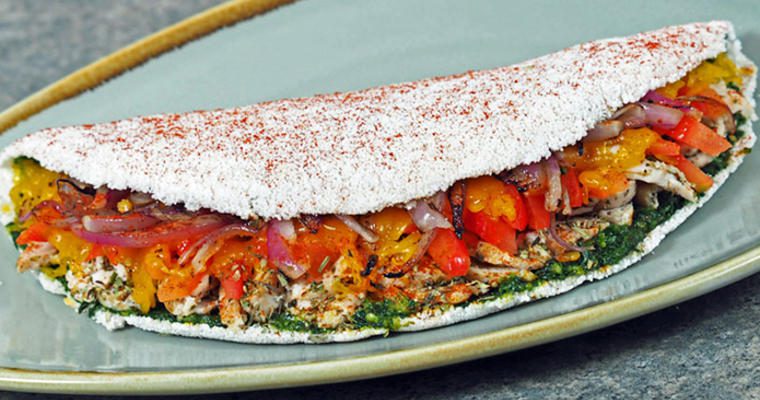In a world of blending dayparts, operators looking for a new twist may want to turn to a south of the Equator opportunity—the Brazilian tapioca. This traditional South American street food is a cross between a pancake, a crepe and a tortilla, ready to rise above its humble roots as a unique handheld. It’s a blank canvas, says Gordon Food Service Corporate Consulting Chef Gerry Ludwig, CEC, one that can be filled with savory or sweet fillings perfect for any daypart and across all menu categories.
This thin pancake is made simply, using tapioca flour (dried and milled yuca root) and water. Instead of mixing them into a doughy batter, only enough water is added to make a mixture of coarse granules. The granules are sifted into a hot stainless-steel pan using a mesh strainer. Once they hit the hot surface, the pearls of flour come together as a thin pancake. Using a pastry brush, they can be shaped to create an even thickness as they quickly cook. Flip them once, and in about a minute you’re ready to create a customizable handheld with clear opportunities for menu differentiation.
For now, Ludwig says New Yorkers are just starting to get their first taste of tapioca pancakes. This means there’s time to be first to market with a unique menu item with potential for customer appeal. During a recent external research tour with the Gordon Food Service Culinary R&D Team, Ludwig visited three restaurants specializing in tapioca that opened in NYC last year. Each one uses the same basic pancake, treating it as open season for chefs to get creative with flavors and fillings.
The right base, unlimited flavor opportunities
It all starts with the base, and Gordon Food Service has developed a proprietary preparation method to create large batches of the flour-granule base. This simplifies the process, ensuring operators always have flour mixture on hand. For details, customers are invited to view our preparation technique video or ask their Customer Development Specialist to learn the process for making and storing the base mixture.
“The base alone can be a bit neutral, but it doesn’t have to be,” Ludwig says. “Infusing the flour with ingredients such as spinach or beet purée at the start creates green or red pancakes that are as flavorful as they are colorful.”
The fillings can be as simple or inventive as desired. Gordon Food Service has developed more than 30 Kitchen-Tested Recipes for the Brazilian Tapioca, demonstrating the variety of fillings. Among the possibilities:
Beef Short Rib Tapioca—yellow peppers, onions, radicchio, beef short rib, tahini cream cheese and wasabi mayonnaise in a spinach tapioca shell.
Thai Chicken and Swiss—with red bell peppers, arugula, chicken and orange curry mayonnaise in a spinach tapioca shell.
Avocado and Swiss—caramelized onions, radishes, yellow peppers, avocado slices, Swiss cheese and gochujang mayonnaise in a curry tapioca shell.
Mediterranean—cremini mushrooms, spinach tapenade and goat cheese in a beet tapioca shell.
Banana and Pineapple—with Parmesan, banana slices and Thai cream cheese spread in a tapioca shell.
Chocolate Strawberry and Banana—cherry cream cheese spread, walnuts, strawberry and banana slices in a chocolate-infused tapioca shell.
Ask your Customer Development Specialist for these and more recipe ideas.
A handheld differentiator
The real opportunity for mainstream operators, Ludwig believes, is creating a marginally thicker pancake that can be used as a handheld.
“Sandwich shops could easily implement this,” he says. “All you would need for a tapioca station is a couple of stainless-steel nonstick pans and an induction burner. A very portable setup.”
He also envisions hotels or resorts offering Brazilian tapioca instead of an omelet bar, filling the pancakes with scrambled eggs, cheese, potatoes and sautéed vegetables as a savory option, or berries, whipped cream and chocolate shavings as a sweet offering.
Any foodservice operation can take advantage of Brazilian tapioca, because it fits any daypart—breakfast, brunch, lunch, snack or dinner. It also fits many menu categories, from appetizer to sandwich to entrée to dessert.
A versatile offering with many benefits
In addition to the quick preparation, endless customization possibilities and portability, Brazilian tapioca offers plenty of other operator benefits:
Volume production. You can create a volume batch of flour to have at the ready. With multiple pans, Ludwig says at a recent demonstration event he was able to make three Brazilian tapiocas in about a minute.
Advance preparation. While the real advantage is being fresh to the table when ordered, it’s possible to prepare them up to two hours in advance of your breakfast, lunch or dinner service. A quick reheat and they’re ready to serve.
A better-for you option. Brazilian tapioca is gluten-free, low in calories and fat-free. The added ingredients will affect how operators can market these advantages.
Cost-effective. From an inventory standpoint, the only addition is the tapioca flour. Depending on how they’re filled, the pancakes are a relatively low-cost menu addition.











